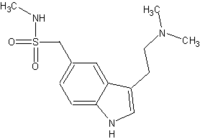About 60 percent of women who have migraine report a correlation of migraine attacks with the onset of menstruation. Nett and colleagues studied the effect of treatment of menstrually related migraine with sumatriptan during the mild phase of pain.
They recruited women 18 to 65 years of age who had experienced migraine in a menstrual pattern (i.e., occurring between the two days before menstruation and the fourth day of flow) for at least one year. For inclusion in the study, women had to report having migraine during at least two of their previous three perimenstrual periods, to be able to distinguish migraine from other headaches, and to have a mild pain phase preceding the onset of moderate to severe migraine pain.
All participants of childbearing potential were required to use birth control. Those with contraindications to use of triptans, risk factors for ischemic heart disease or stroke, persistent tension headaches, or current use of ergotamine or monoamine oxidase-inhibiting drugs were excluded from the study. Investigators randomly assigned 349 women at 39 centers to placebo or treatment with 100-mg or 50-mg tablets of sumatriptan. Patients were instructed to take the study medication within one hour of onset of new migraine pain while the pain was still mild in severity. A second dose or use of a rescue medication was permitted if pain was not relieved within two hours or if severe pain recurred within 24 hours. Patient assessments included medical history, physical examination, headache-related disability as measured by the HIT-6 standardized disability questionnaire, and a symptom diary.
The 118 women assigned to placebo did not differ in any important variables from the 116 women assigned to 50 mg of sumatriptan or the 115 women assigned to 100 mg of sumatriptan. Two hours after taking the medication, a significantly greater proportion of patients taking sumatriptan were pain free (51 to 61 percent) compared with patients taking placebo (29 percent). Approximately 30 percent of patients in both sumatriptan groups remained pain free for 24 hours without additional medication, compared with only 14 percent of the placebo group (see accompanying table).
Greater proportions of patients also reported freedom from nausea and photophobia or phonophobia two hours after treatment with sumatriptan, but these differences were only statistically significant in patients taking 100 mg of sumatriptan who also had relief of photophobia or phonophobia. Adverse events were reported by 7 percent of patients in the placebo group, 8 percent of patients in the 50-mg sumatriptan group, and 16 percent of patients in the 100-mg sumatriptan group.
The authors conclude that both dosages of sumatriptan provide significant pain relief in menstrually related migraine when taken early in the attack. The 100-mg dosage is more effective but is associated with more adverse effects. These results are comparable to those of studies of nonmenstrually related migraine.
Nett R, et al. Pain-free efficacy after treatment with sumatriptan in the mild pain phase of menstrually associated migraine. Obstet Gynecol October 2003;102:835-42.
EDITOR'S NOTE: Triptans are very effective and usually well-tolerated medications in the treatment of all forms of migraine, yet some patients in this study were profoundly disappointed. Most of these patients expected rapid relief of pain and ability to return to usual activities without recurrence of migraine. The two-hour delay and high rate of recurrence was not acceptable. We need to give our patients accurate performance expectations for each of the migraine therapies and select the therapy and route of administration that best meets the patient's priorities. Looking carefully at this and other studies, oral triptans seem to allow two thirds of patients to be free of pain at two hours and one third to stay pain free for 24 hours, depending on the agent used. The numbers become less impressive when the placebo effect is deducted or comparisons are made against analgesics. One famous study (1) found that aspirin and metoclopramide performed as well as 100 mg of sumatriptan and had fewer side effects. We now have many therapeutic choices in the treatment of migraine; the challenge is to our skill as personal physicians to help patients find an effective treatment strategy and persevere with confidence in the regimen.--A.D.W.
REFERENCE
(1.) Tfelt-Hansen P, Henry P, Mulder L, Scheldewaert RG, Schoenen J, Chazot G. The effectiveness of combined oral lysine acetylsalicylate and metoclopramide compared with oral sumatriptan for migraine. Lancet 1995;346:923-6.
COPYRIGHT 2004 American Academy of Family Physicians
COPYRIGHT 2004 Gale Group



